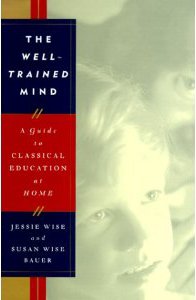We have some friends living down in Australia who started homeschooling this year. They asked us to explain a little big about how we go about it. I have not written about how we go about for quite awhile, so I thought I would explain a little bit about our curriculum and methods. Today I will discuss our curricula with a follow-up post in a day or so about what a typical day is like for us and a final post on how we plan to prepare the kids for college and how we test them to make sure they are getting what they need academically.
Homeschool methods update – Part 2 of 3 – a typical day
Homeschool methods update – Part 3 of 3 – college
The core of our curricula is from Sonlight. We believe their forte is their history and literature programs. This year, Christian is doing a one year survey of non-Western cultures. Christian’s program includes twenty some novels that are mostly Newbery and Caldecott Award winning books centered around the culture and time about which Christian is studying. Kelly is finishing her second year of a two year survey of world history, starting from the dawning of time and finishing in the 1990’s. Her program includes the same kind of high quality novels as those Christian is reading, but that cover the eras, places, and people she studies. Examples of the history books that she reads include Caesar’s World, George Washington’s World, and Abraham Lincoln’s World all by Genevieve Foster and Susan Rice Bauer‘s The Story of the World collection who is also the author of The Well-Trained Mind: A Guide to Classical Education at Home. The thing that comes with the program that we avoid is their religious materials. The reality is that some of it is not that bad, but our aversion to organized religion, a paid ministry, and church buildings make some of them a little hard to take, so we just avoid them.
We also use the Sonlight Science programs because they are very well done. We have a great little addition to the science that is kind of funny, kind of fun, and very educational. It is series of books from company called Lyrical Learning. The kids are currently in Lyrical Life Science Volume. The sing songs about science topics and it really helps them remember some very complicated materials. And they have fun doing it.
Sonlight provides a variety of math options. Both Kelly and Christian did their elementary school math in Singapore Math. It is a program put out by the Singapore Ministry of Education. Singapore has the best elementary school math students in the world. We understand why that is true after having used the materials. Now, though, Christian has moved on to Teaching Textbooks Prealgebra and Kelly has gone on to Teaching Textbooks Algebra I. These are awesome math programs specifically tailored for the homeschool student. The program they provide is very systematic, easy to understand, and full of feedback, both for the parents and the students. Lorena is taking a calculus class at the University right now as she works toward her degree so we are all pretty well saturated in math for the moment.
For grammar we use the Easy Grammar series. Kelly has just moved from grammar into Easy Writing. We love these books. They are super for allowing the kids to learn the material on their own and get a solid foundation in English grammar. We use the Wordly Wise Series for vocabulary. The books are irritatingly politically correct and just flat wrong in some of the essays they use to get the kids to understand and use the words, but the vocabulary work is excellent. We do lots of things for writing. The kids write annual research reports, a quarterly magazine to send out to friends and family — the February issue will be the first one where some of our homeschool friends in Texas will be writing an article (and it is a good one). They do some daily writing work out of the Wordsmith series, but now that the kids are a little older, we are probably going to move on to the WriteShop series. We also give them assigned letters once per week or so and a current events paragraph from World Magazine every Friday. The kids are both fluent in Spanish because we speak it at home as our first language. We have them both working on in Rosetta Stone Spanish to get a better academic understanding of the language. We plan to move on to French in a couple of years.
On the side, both Kelly and Christian have hobbies. Kelly writes constantly. She is writing and illustrating a series of short stories right now. Christian has learned to write C# programs and loves to do claymation and 3D animations using the Blender program on the computer. He is also a Boy Scout. We do a LOT of reading aloud together and, in during the summer, spend a half an hour each evening listening to classical music and going through a drawing program.
Swimming has been the bulk of our physical education effort up until now. Kelly and Christian are both good swimmers now, so we will be transitioning them into tennis for awhile. Kelly is in her seventh year of piano. She performed in a Bach Festival yesterday and performs regularly at recitals. Christian took three years of piano lessons and then switched over to guitar. With a fellowship meeting and two gospel meetings per week, and playing with the neighborhood kids it is pretty hard to stay caught up with everything.
That is not all we do for homeschool, but it is the bulk of the academic stuff. We take an annual trip to downhill ski with another homeschool family once a year, we communicate in various ways with professing homeschool families in Texas, Arizona, California, and Arkansas. We visit museums, etc., etc. One thing we know is that we will never go back to what the government is providing. We are not against the government schools, but it is very difficult to understand how any of those kids ever get socialized, what with spending their time in a room with one or two teachers and thirty or so students of the exact same age as themselves. They never get a chance to get out and meet anyone or learn to function socially with anyone other than an isolated group of peers who do not have the benefit of having experienced anything else. It is like Lord of the Flies.



 As many already know, Kelly and Christian take a “writing” class at the community college where the dear leader of the class lectures on the evils of all things Christian, the beauty of communism and atheism, and the righteousness of drug legalization and abortion. Today’s topic was Christianity. He said he spoke about Christianity because we live in Raleigh. He would have made his outrageous, silly arguments about Hindu if we lived in India. Kelly read up a little over at the
As many already know, Kelly and Christian take a “writing” class at the community college where the dear leader of the class lectures on the evils of all things Christian, the beauty of communism and atheism, and the righteousness of drug legalization and abortion. Today’s topic was Christianity. He said he spoke about Christianity because we live in Raleigh. He would have made his outrageous, silly arguments about Hindu if we lived in India. Kelly read up a little over at the 



























